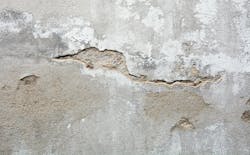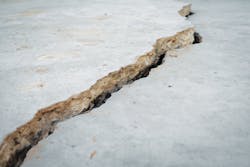You can get into trouble making too many assumptions in the construction industry. When it comes to concrete, a wrong assumption could mean not catching a serious structural problem.
Concrete problems may range from purely aesthetic to structural failures that require the concrete be replaced. In most cases, an economical, temporary concrete repair will alleviate an aesthetic situation while budgeting for a more permanent solution. The key is to diagnose the concrete problem and plan.
Let’s Get Cracking
There is an old adage in the concrete repair community, “There are two classes of concrete complaints: cracks and everything else!” The reason cracked concrete holds the top slot in the concrete repair arena is simple: all concrete cracks. Concrete is incredibly strong in its compressive strength but extremely weak in its tensile strength. Diagnosing cracked concrete and the remedy one chooses to apply depends upon its severity.
Cracks in concrete will fall into one of these categories or a combination thereof:
- Plastic shrinkage
- Crazing or map cracking
- Drying shrinkage cracks
- Expansion
- Crusting
- Settlement
- Heaving - root or frost heave
- Overloading (which can result from improper footings or design)
- Premature loading
- Corrosion induced
- AAR - alkali aggregate reaction
Aesthetic Cracks
Hairline cracks are aesthetically displeasing surface cracks that are too thin to be of structural concern. The two prevalent types of surface cracking are plastic shrinkage cracks and crazing/map cracking.
These happen when the concrete is setting and the rate of evaporation of surface water is higher than the rate of replenishment of upward rising water, known as bleed water. It is caused by wind, direct sun (heat), and humidity. Simply seal the surface with a film-forming sealer, or in the case of map cracking, one might employ a water-based concrete stain.
There are two classes of concrete complaints: cracks and everything else!
Structural Cracks
Once a slab is cracked, it is cracked. Any crack that goes through a slab is structural, including the installed control joint. All cracks emit moisture into a slab and any crack larger than ⅛” should be sealed. Leaving cracks open subjects the concrete to future problems and shortens the life of the slab. This rule includes sealing control joints.
Getting to the root of the situation will help build a repair plan. One may decide to apply a temporary fix while working with a concrete repair specialist for a more permanent or longer-term solution.
The most common types of concrete cracking experienced are drying shrinkage and expansion cracking. Certain factors of the crack(s) determine what material and method is best by determining if the crack is still active: Is the crack interior (in heated space) or exterior? How wide and what is the visible depth of the crack? Does the crack move, ie. expand or close in the summer, and widen in the winter? Is the crack growing in length or continuing to widen?
As a rule of thumb, exterior concrete cracks are active. When in doubt, seal or fill the concrete crack with a material that will remain semi-flexible. Rigid repairs on an active crack will just lead to new cracking.
Examples of flexible crack filler for concrete range from polymer solutions to more heavy-duty polyurethanes. Read and pay strict attention to the product’s recommended application width and depth limitations to help make an informed decision.
Sometimes a crack is structural yet remains tight on the surface. In these cases, it is advised to open the crack by crack chasing to create a sealant reservoir.
Other cracks mask greater concern. Examples of these are settlement and heaving cracks. These cracks have an underlying cause; something has occurred between the bottom of the concrete and its substrate. For immediate pedestrian safety, consider creating a “ramp” of patch material to temporarily abridge the two concrete levels, thus reducing the trip hazard. A specialist or contractor should be consulted to plan a permanent fix.
Overloaded Concrete
A slab that looks shattered is just that—the slab or sidewalk has been overloaded.
It is not advisable to try and patch an overloaded slab, as you are just throwing good money after bad. This concrete will need to be removed, the sub-grade must be addressed and recompacted, then the concrete re-poured.
Diagnose what loads will be expected on the concrete in the future and upgrade the concrete strength and thickness to better match the needed performance.
A clear example would be that most dumpster pads, whether asphalt or concrete, have been under-designed and should be replaced with concrete rated at 5000 PSI at a correct thickness to match its use. Consult an engineer or a local ready-mix concrete provider for direction in determining the replacement depth of the concrete – 4 inches isn’t always enough.
RELATED: How to Solve the Deck Ledger Problem in Fat Walls
Use Available Resources
There are numerous resources readily available to help diagnose concrete problems. A great source of types of concrete problems has been published by the National Ready Mixed Concrete Association (NRMCA). They are known as CIPs or Concrete In Practice bulletins – think of them as WebMD for concrete.
The American Concrete Institute, or ACI, offers a Repair Application Procedures (RAP) certificate program made up of courses on the repair of cracking and spalling, reinforcement protection, as well as surface repair.
Look to ICRI, the International Concrete Repair Institute, as a valuable source for the latest in concrete repair techniques and insights.
Learn from building material manufacturers. Read websites from well-known concrete ready mix suppliers, repair material suppliers and admixtures, such as Sakrete, Grace, Master Builders, and Euclid, just to name a few.
The bottom line is to use your concrete crack investigation as a learning experience. The industry wants educated contractors, finishers, remodelers, home owners, and DIYers, in short, anyone who comes in contact with concrete.
Never ignore the problem, no matter how minor it may seem on the surface. Educate yourself, diagnose the problem, address the problem. Because as incredible as concrete is, one thing it will never do is heal itself.
Dave Jackson is the Oldcastle APG Senior Brand Manager of Sakrete and Amerimix. Dirk Tharpe is Oldcastle APG’s Sakrete Concrete Expert.



